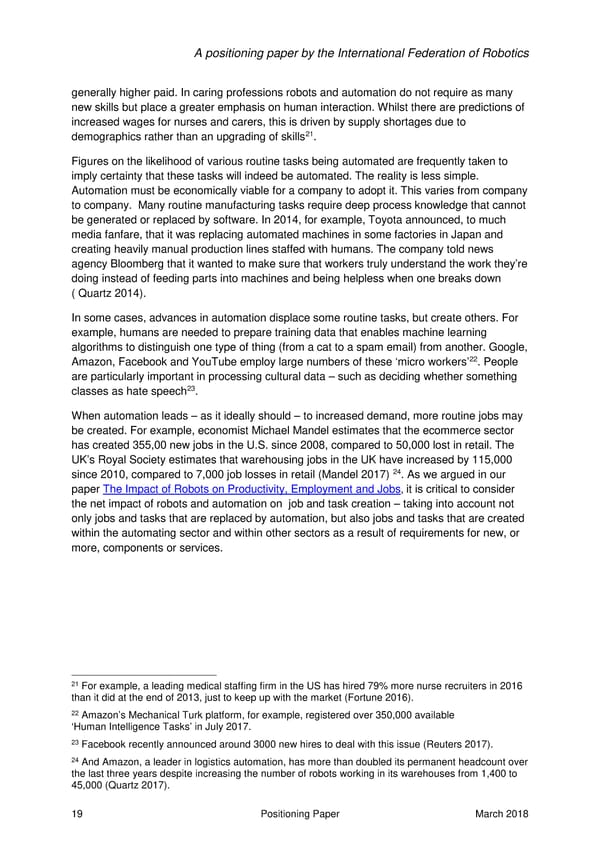A positioning paper by the International Federation of Robotics generally higher paid. In caring professions robots and automation do not require as many new skills but place a greater emphasis on human interaction. Whilst there are predictions of increased wages for nurses and carers, this is driven by supply shortages due to demographics rather than an upgrading of skills21. Figures on the likelihood of various routine tasks being automated are frequently taken to imply certainty that these tasks will indeed be automated. The reality is less simple. Automation must be economically viable for a company to adopt it. This varies from company to company. Many routine manufacturing tasks require deep process knowledge that cannot be generated or replaced by software. In 2014, for example, Toyota announced, to much media fanfare, that it was replacing automated machines in some factories in Japan and creating heavily manual production lines staffed with humans. The company told news agency Bloomberg that it wanted to make sure that workers truly understand the work they’re doing instead of feeding parts into machines and being helpless when one breaks down ( Quartz 2014). In some cases, advances in automation displace some routine tasks, but create others. For example, humans are needed to prepare training data that enables machine learning algorithms to distinguish one type of thing (from a cat to a spam email) from another. Google, Amazon, Facebook and YouTube employ large numbers of these ‘micro workers’22. People are particularly important in processing cultural data – such as deciding whether something classes as hate speech23. When automation leads – as it ideally should – to increased demand, more routine jobs may be created. For example, economist Michael Mandel estimates that the ecommerce sector has created 355,00 new jobs in the U.S. since 2008, compared to 50,000 lost in retail. The UK’s Royal Society estimates that warehousing jobs in the UK have increased by 115,000 since 2010, compared to 7,000 job losses in retail (Mandel 2017) 24. As we argued in our paper The Impact of Robots on Productivity, Employment and Jobs, it is critical to consider the net impact of robots and automation on job and task creation – taking into account not only jobs and tasks that are replaced by automation, but also jobs and tasks that are created within the automating sector and within other sectors as a result of requirements for new, or more, components or services. 21 For example, a leading medical staffing firm in the US has hired 79% more nurse recruiters in 2016 than it did at the end of 2013, just to keep up with the market (Fortune 2016). 22 Amazon’s Mechanical Turk platform, for example, registered over 350,000 available ‘Human Intelligence Tasks’ in July 2017. 23 Facebook recently announced around 3000 new hires to deal with this issue (Reuters 2017). 24 And Amazon, a leader in logistics automation, has more than doubled its permanent headcount over the last three years despite increasing the number of robots working in its warehouses from 1,400 to 45,000 (Quartz 2017). 19 Positioning Paper March 2018
 Robots & the Workplace of the Future Page 19 Page 21
Robots & the Workplace of the Future Page 19 Page 21